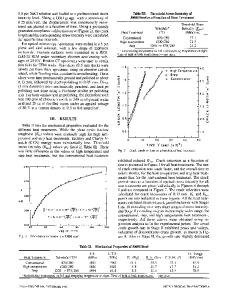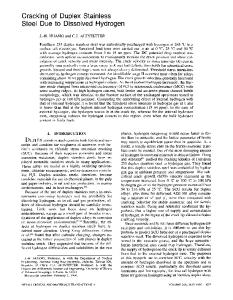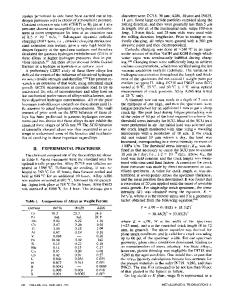Hydrogen Cracking in Nominally Pearlitic 1045 Steel
- PDF / 1,673,597 Bytes
- 4 Pages / 594 x 774 pts Page_size
- 15 Downloads / 345 Views
Recent reviews of microstructural effects on hydrogen embrittlement 1'2 have noted that considerable variability of results exists in the literature regarding pearlitic microstructures; in particular, the ranking of hydrogen embrittlement resistance of pearlite, compared to other steel microstructures (tempered martensite, tempered bainite, and spheroidized), varies from investigator to investigator. Some of the variability probably arises 2 from the use of normalized (ferrite plus pearlite) structures rather than fully pearlitic structures in some studies, so that pearlite behavior is partly inferred rather than directly measured. One purpose of this work was to study hydrogen effects on a fully pearlitic microstructure. Work by Garber and Bernstein 3 on tensile specimens of eutectoid steel showed that the hydrogen performance of pearlite, relative to spheroidite, depended on strength level; at low strength, about 470 MPa (68 ksi) yield strength, the two microstructures were roughly equivalent, while at high strength, about 645 MPa (94 ksi) yield strength, pearlite was clearly inferior. All specimens of both microstructures failed by microvoid coalescence (MVC) without hydrogen. The pearlite predominantly failed by cleavage when hydrogen charged, while the spheroidite continued to exhibit MVC. It was a second purpose of this work to extend these observations to include fracture in pearlitic 1045 steel under notched slow-bend conditions, using materials and techniques described earlier. 4 A microstructure of essentially 100 pct pearlite was obtained as follows 9 After austenitizing for one hour at 1365 K, specimens were furnace-cooled to 1090 K and quenched from this final austenitizing temperature into a molten salt bath at 805 K and isothermally transformed. With this processing, only occasional films of proeutectoid ferrite (less than 1 vol pct by point counting) were observed at prior austenite grain boundaries (grain size 300/zm). Pearlite colony sizes averaged about 2 0 / z m , while the spacing of cementite plates was about 0.25 /zm. Four tensile and nine notched slow-bend tests were performed on uncharged and hydrogen charged specimens. Specimens, test tectmNues, and tlyarogen charging procedures were the same as in earlier work. ~ In tensile tests, the yield and ultimate strengths of this material (see Table I) were not reduced by hydrogen, but ductility suffered a loss of 82 pct in RA. This is consistent with results 3 for 1080. The fracture mode of uncharged specimens was virtually 100 pct MVC (Figure l(a)), but fractures with hydrogen revealed nearly 100 pct cleavage JAMES E. COSTA and ANTHONY W. THOMPSON are, respectively, Graduate Student and Professor, Department of Metallurgical Engineering and Materials Science, Carnegie-Mellon University, Pittsburgh, PA 15213. Manuscript submitted November 2, 1981.
METALLURGICAL TRANSACTIONS A
"l~ble I.
Results of Tensile Tests
Yield Ultimate Reduction Strength,* Strength, in Area, Loss in
Material MPa MPa Uncharged pearlite 560 850 Hydrogen-charged pearlite
Data Loading...











